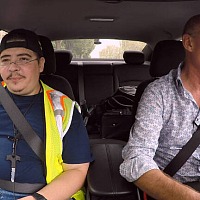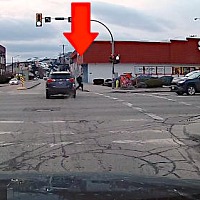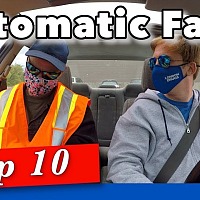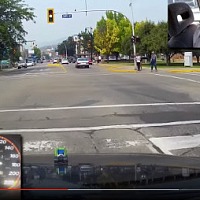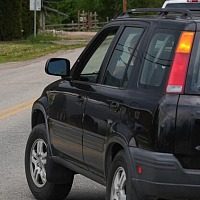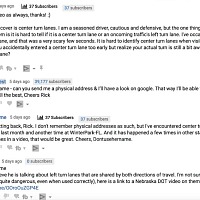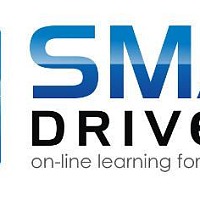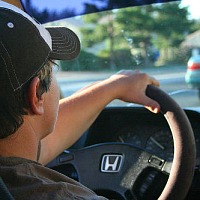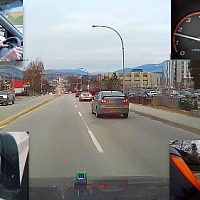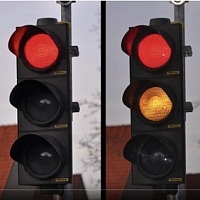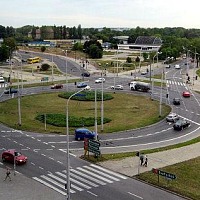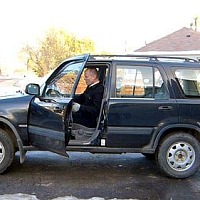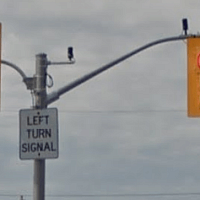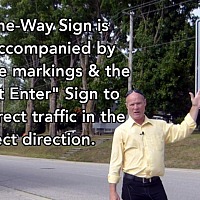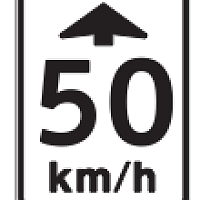Want to know how to Reverse Stall Park for your driver's licence road test? Watch the video.
How to Reverse Stall Park | Road Test Smart
Closed Caption
Introduction
Hi there smart drivers.
Rick with Smart Drive Test talking to you today about stall parking, sometimes called bay parking.
Essentially what you're going to do is you're going to put a vehicle into a parking space in a parking lot or it's called a car park in Australia or in the UK and other places.
I had a comment from Ganti Sunita and Salima Mohand Oussaid - both of those smart drivers wanted me to go over the procedures for reverse stall parking for the purposes of a road test.

LEARN THE SECRETS THAT DRIVING SCHOOLS DON'T TELL YOU!
• FEAR :: Know that you WON'T have to face friends & family and tell them you didn't pass;
• SELF-CONFIDENCE :: Get the exact skills from a licensed driving instructor that will guarantee your success;
• CONFUSION :: Cut through the conflicting driving procedures information;
• QUALIFIED :: Smart Drive Test has helped 1000s pass their driver's test...and we can help you!
Actually I want to apologize for Salima, she was trying to get me to do this earlier and unfortunately I was having a brain cramp and didn't understand perpendicular parking, which is essentially what this is is stall parking.
So my apologies to Salima.
Now the first thing you have to do before you start reverse stall parking for the purposes of a road test is practice backing up.
Because this is essentially backing up and if you're not comfortable with backing up and you're reversing skills are not high then you're going to have a great deal of difficulty stall parking the vehicle.
So go out and do reverse parking: straight line reverse parking, and then reversing around corners, and finally reverse figure '8s'.
Once you get comfortable with all of that, then I would suggest that you go and start practicing stall parking.
Actually stall barking is fairly straightforward after you have some practice backing up and get comfortable with how the primary controls react for the purposes of backing up a vehicle.
And the other thing that I would suggest - a lot of driver education focuses on getting the vehicle between the lines and unfortunately what happens with students is that they start focusing on the lines and they start looking down at the ground.
You don't want to be looking down at the ground.
You want to have your vision up; so the first tip that I'll give you for reverse stall parking is always try and park off another vehicle.
If you can park off another vehicle, your vision is going to stay up and therefore you're going to be looking in the places that you need to be looking, as opposed to down on the ground because that just draws your vision down and doesn't allow you to take in the 360° degree scan that you need to do for the purposes of stall parking.
Two other points that I'll make about reverse stall parking - if you feel obsessed about backing into the stall and getting between the lines and actually looking at the lines, what I would suggest is go out and purchase those small stick on convex mirrors.
And those small convex mirrors will allow you to be able to see the lines without actually looking down and getting your vision drawn down to the ground.
And the other point that I'll make about reverse stall parking: when you get the vehicle--what you feel is more or less straight into the space--look forward; look out the front windshield to determine if the vehicle is in fact straight.
Because that will help you to line up.
It's a lot easier to look forward than it is to look back and determine whether the vehicle is 90° degrees and straight into the space.
So those are two tips that you can use in order to get the vehicle into the stall if you don't have another vehicle to park off.
So what we're going to do today, we're gonna go to the parking lot, and going to go over how to do that and show you how to do that.
And we're going to do a little bit more work here in the studio and I'll go over with you on the whiteboard the procedures for reverse stall parking, which is a required technique for the purposes of a road test.
Stick around, we'll be right back with that information.
Hi there smart drivers, welcome back.
Rick with Smart Drive Test talking to you today about reverse stall parking for the purposes of a road test.
It is one of the slow speed maneuvers that you will almost always be required to do for the purposes of road test.
And at many licensing center, they are going to have designated parking.
When you go into the licencing center in preparation for doing your road test make sure you back into the space.
If you go with the driving school, the driving instructor will make you back into the space prior to starting your road test.
If you go by yourself, know that you need to back in.
You're just too nervous at the beginning of the road test.
So make sure you back into the space.
That way you've had a little bit of practice and it helps to relieve the stress of getting in and going out on your road test.
That way when you depart for your road test you simply drive out of the space and commence your road test.
When you come back from your road test and you calm down a little bit, and you have a little bit of a rapport with the driving examiner, then you're going to back into the space and the examiner will get you to do that in almost all situations, regardless of where you are in the world.
You're going to have to back into that space because it's a required maneuver on a road test.
Practice Backing
Now the first thing I will say as stated in the introduction, make sure that you practice reversing before you actually attempt to stall parking.
Get comfortable with backing the vehicle up and the response of the primary controls, particularly the steering in reverse.
Because it's quite a bit different than it is when you're driving forward.
It feels a little bit weird and as well, when you're reversing you're looking out the back window and you've got one hand on the passenger seat and the other hand is on the wheel.
So you're turning the wheel with one hand, which makes it a little different as well.
What I suggest in terms of practicing backing: back up straight line; when you get comfortable straight line backing, then start backing around corners; when you get comfortable with that, back around corners.
Go out and get a couple of pylons in a parking lot or whatnot and do reverse figure '8s'.
When you're comfortable with all of that--straight line backing; back around corners; and reverse figure '8s', then you can start stall parking.
And again, as I said in the introduction you want to try and park off another vehicle - that is the ideal.
Because if you have another vehicle, that vehicle is going to be your landmark and you're not going to be looking down at the ground trying to find the pavement markings in the parking lot.
Because if you're looking down, your vision isn't in the right place for detecting other obstacles and hazards around the parking space where you might be parking.
So you want to try and keep your vision up and if you can park off another vehicle that's what you want to do.
If you're going to drive into the space, you simply want to drive down the center of the lane here as best you can.
Straight Line Reverse Parking
Of course, with other vehicles and those types of things you might have to move over, but essentially if this is the space you want to park into when your vehicle is here and you are here.
And again, it's the same for setting up for straight line backing or angle backing.
When you're at the halfway point of the space preceding the space that you want to move in to, turn the steering wheels and drive into the space.
And again, look where the reference points are other vehicles, those types of things.
Whether there are trees and those types of things down here, but simply look forward drive into the space.
Again, always go slowly because the slower you go, the sharper the vehicle turns.
And you have more control of the primary controls and more time to react.
If you go tearing into the parking lot, you're not going to have as much time to react and could risk a collision.
And again, on your road test make sure you look--do your 360° degree scan before you back up into the space.
That is critical because for the slow speed maneuvers, the examiner is looking that you are observing and looking for other pedestrians and other hazards and obstructions that you could potentially strike.
So what we're going to do here, we're going to the vehicle and we're going to show you how to do this in the vehicle.
There's three ways to do a reverse stall park:
1) one is a straight line back;
2) angle reverse parking
3) perpedicular stall parking
and essentially for straight line back and angle, you position the vehicle on on an angle when you set up to back into the space.
It's essentially the same setup.
So when you're here...
and you in the vehicle are at the halfway point of the parking space immediately preceding the space into which you want to park, that's when you turn your wheels all the way to the right for straight line backing.
Now as well, for straight line backing, if you're in a car park or a parking lot know that this space here is going to be in line with that space in most cases, not all cases, but in most cases.
And again, if you're going to the licensing center and you know where you're going to take your road test, scope that out.
Go in on the weekend, check out the parking spaces and know where you're going to park.
Now the other point about this is that obstacles and landmarks are one and the same thing for the most part.
| Don't Fail Your Road Test!! | |

A course for new drivers working towards their first license. This self-paced course gives you:
|
Landmarks & Obstacles
People are obstacles - you can't really use them as landmarks because you know, they're pretty hard to keep them stationary so that they can stay in one place.
So scanning and observation are also really important for the purposes of backing up.
And make sure that you do your 360° degree scans.And do that almost every vehicle length, because as we know parking lots are dynamic - they're busy, there's a lot of stuff going on, and as I said landmarks and things that you could potentially strike are one and the same thing as obstacles.
So oftentimes you want to try and park off another vehicle because that will keep your eyesight up.
If you're looking down at the lines on the on the pavement it's going to draw your sight down.
And you don't want your sight down; you want your sight up.
So if you can park off another vehicle that's ideal.
As well, if there's a fence or a tree or something back here, take note of that.
If there's a vehicle in this space here, take note of whether that vehicle is far ahead in your space because then you can't back into the space as far - those types of things.
So when you pull up here in preparation to set up to back into the space, take note of the landmarks - take note if there's a vehicle in this space here - is that a green vehicle; is that a red vehicle; is that a black vehicle?
All that will help you as you're backing into the space because you can position your vehicle in relation to these other vehicles.
And essentially that's what you're doing, you're trying to position your vehicle in relation to other fixed objects and other vehicles.
So take note of what's around you and look for landmarks as you're coming into your space.
So the first one: straight line backing.
Line yourself up as the driver at the halfway point of the space immediately preceding the parking space you want to pull in to.
Pull around to the right, line yourself up with this space--if it in fact is in line with this space--and simply back straight up.
You're going to put your right hand on the back of the passenger seat, steer with your left hand and look out the back window.
The UK & Australia
For those of you on the other side of the road in the UK (United Kingdom) and in Australia, you're going to put your right hand on the steering wheel and your left hand the back of the passenger seat.
And look out the rear window to back up.
Back into the space.
And again, if there's a vehicle here you want to line the front of the vehicles up with this.
For you, your reference point is going to be the mirrors.
If there's a vehicle in this space you want to line the two mirrors up and that way you know that you're back into the space far enough.
If you're unsure, it's better to be out of the space a little bit then back up too far and strike whatever is behind you.
Usually at these licensing centers they have concrete barriers there so make sure that you don't back into the concrete barrier.
So that's a straight line back into the reverse stall park.
The next one is an angle park.
 Angle Reverse Parking
Angle Reverse Parking
So you come up here - it's the same setup as a straight line back, so you as the driver are at the halfway point of the space preceding the space into which you want to park.
When you pause or stop here pick a 45° degree angle.
And it's going to be approximately off the corner of the front corner of the hood is going to be your 45° degree angle.
You pull up and you line up the front of your vehicle with that mark.
So here it's the corner of this parking stall here and you line your vehicle up approximately here.
The back corner comes here and then you back into the space.
So that's how you set up your vehicle for an angle back up.
The last set up for revers stall park is to do a perpendicular park.
So essentially what you're going to do is you're going to pull up here and you're going to go one, two spaces past.
So here there would be another space here.
You drive up so your vehicle is positioned here.
That vehicle is probably a little big, but essentially what you want is the front of your vehicle here.
You want to be at the halfway point one, two spaces past the space into which you're going to park into.
You pull up so you as the driver are here.
Two spaces at the centrepoint past the one you want to park into.
Put your vehicle into reverse--the reverse lights come on--put your left signal on here, turn the steering wheel all the way to the left, which is one-and-a-half turns on most passenger vehicles.
Again, just check that out when you start driving; just while you're in the parking lot, or you're sitting somewhere stationary, turn the steering wheel all the way to the left or all the way to the right and make sure that it is in fact one-and-a-half turns.
Reverse Stall Parking
Because it might be between one and a half and two turns both ways.
But if you know how far the steering wheel goes: one-and-a-half turns all the way to here - when you get the vehicle...at approximately this position here, look forward out the front windshield.
That way you have a really good reference point of whether the vehicle is straight or not.
When you vehicle is almost straight bring the wheels back to center.
So it's going to be one-and-a-half revolutions on the steering wheel to bring it back to the right.
And then simply back up and again look out the back window.
If there's a vehicle beside you ,that's the best because you can use that vehicle beside you as a reference point.
And simply line up the mirrors or the front of the vehicles and then stop.
When you're done parking you secure the vehicle by applying the parking brake, putting it in Park--most of you are going to be driving an automatic--if it's not an automatic, put it into forward gear.
Shut the vehicle off and tell the examiner that you're finished and the vehicle has been parked.
Now a couple little techniques:
if you really want to make sure that it's in between the two lines, go out and get yourself those little convex mirrors.
They're fairly inexpensive.
I'll put a link down here to Amazon for the convex mirrors and you can put those on your mirrors and those will show you the lines on the the pavement markings down on the bitumen or the pavement down there.
And those we'll help you get in between the lines.
But like I said, most of the time if there's another vehicle there, you want to park beside that other vehicle.
That is the ideal because that way your vision is up and it's not directed down at the ground.
Because we don't want to be looking at the ground when we're driving vehicles - that's ideal!
So this is the theory behind perpendicular parking.
Practical Parking
And what we're going to do today, we're going to go and show you how to do that.
So you come into the space and you don't actually need the lines on the road to be perfect.
But what you need to do is you need to park off the other vehicle.
So we're coming up to the space here and we're looking at the landmarks.
The Audi at the back is actually far ahead, so we want to pull ahead until we're in line with the edge of the second vehicle.
Put it into reverse, put our signal on.
That way our reverse lights are on and people know that we're backing up.
We turn our steering wheel all the way to the right here.
And we start backing up and we're looking over our right shoulder and we're backing up.
We're watching that car, we're looking behind us and now we're almost straight.
Now we look forward to see if we're straight.
We have our wheels cranked all the way to the right, now we bring our steering wheel back one-and-a-half turns.
We know our steering wheel is straight now and now we back up.
And we're not going to back up totally into space because we checked before we pulled up where the Audi was behind us.
The audi was deep into the space, so we're going to stop here.
And actually we're straightforward.
We're next to that car really closely; nicely beside that car beside us.
And that's how you back up into a stall park, and that's the easiest thing to do.
So when you come up look for landmarks.
If you can back off another car that's going to be the best.
We're going to go find another space and we're going to drive into that space.
From the center of the lane of where we're going to pull into the space.
So we leave the space...
mirror, signal, shoulder check - 360° degree scan - pull out of the space and we're gonna pull in beside the pickup truck.
And we're in the center of the lane.
We come up until...
this car is far away--you can probably see that in the camera--from the truck.
So we're going to move past that until we're halfway in the space before the truck.
So my body lined up halfway, then we turn our wheels into the space.
Not all the way, just looking where you want to go.
And we're measuring about three feet from the truck - right there.
And bring the wheels back to straight and we stopped in the space.
And that's how you drive into a space.
Alright, when you're parking on an angle you want the front corner of the hood in line with the back corner of the vehicle.
So that your passenger side, front corner of the windshield in line with the rear of that vehicle...
the driver side corner on the back of the other vehicle that you're going to park beside.
And you can see that in the dash cam here.
And i'll put a arrow up there for you, so you know and then just right there.
When they're lined up, start turning.
You gotta go a bit wide and come back.
Bring your front end back into the space.
3 feet away from the vehicle.
there's nothing behind the car back there, but he's a fair distance back so 1 space, 2 spaces.
I can't see the lines but I'm estimating.
Signal on, into reverse, reverse lights come on and backing up.
Do a 360° scan before commencing reverse motion.
When you're almost straight, we look forward, and bring the steering one-and-a-half turns back to straight.
Continue to back up a little--bit of adjustment here to be straight off that other vehicle-- look behind us, we're good.
360° degree scan.
From the vehicles we can see we are lined up.
Put the vehicle in park, parking brake on and in the first gear if you're driving a manual transmission.
Stop the vehicle and you're done.
[MUSIC: MEAN STREETZ--Downloaded from YouTube's Audio Library]
Conclusion
 Quick review of reverse stall parking sometimes called bay parking or perpendicular parking.
Quick review of reverse stall parking sometimes called bay parking or perpendicular parking.
You will have to do this for the purposes of a road test.
It is a required slow-speed maneuver to demonstrate that you have due care and control of the vehicle in a confined space.
Landmarks and potential hazards and obstructions that you could strike are one and the same thing.
Take note of what is around the parking lot, if you can park off another vehicle...if you can't park off another vehicle, go down to the end of the stalls and park in the end stall.
It is going to be easier because you're going to have more landmarks.
As well, if you're obsessed with parking between the lines and need to see the lines, go buy the little convix mirrors and put them onto your mirrors so you can see down onto the pavement without actually looking down at the payment.
Because you want to try and find landmarks that will keep your eyesight up.
As well, know that the steering wheel turns one and a half turns in each direction.
And just try that with the vehicle that you are operating.
Most of them do turn one and a half turns in either direction from full turn back to straight.
So that way you know when your wheels are going to be straight when you're backing into the stall.
Before you actually do go over and start stall parking, practice backing up.
Back up in a straight line; back up around corners; and then reverse figure '8s'.
When you feel comfortable with the primary controls with the car in reverse, the vehicle in reverse, then start taking on stall parking.
Practice stall parking where there aren't other vehicles and then move to a vehicle and move to tighter and tighter spaces.
Finally, when you get comfortable with all that - you know where the landmarks are.
When you're going to do perpendicular park, as in parallel parking, you need to be about three feet from the vehicles that you're going to park beside.
Pull up halfway into the second space beyond the one that you're going to park in, crank the wheel all the way to the left or right, depending on which way you're coming in from, crank into this parking space.
When you're going to angle park, you're gonna pull up so you're halfway on the space before the space that you're going to park in.
Pick out your 45° angle and drive to your 45° angle.
And then back into your space.
Straight line backing is the ideal, but a lot of parking lots are just simply not going to have enough room that you are going to allow you to pull up and then back in straight into the space that you're going to back into.
So most of the time, it's going to be angled parking or perpendicular parking.
If you drive into the space when you come up, you're going to try to be in the center of the lane between the two lanes of parked cars.
At the halfway point of the space immediately before the space that you're going to turn into, and then turn in and center the vehicle in the space.
And again.
all this takes practice if you're in confined spaces.
And the last point about parking into a parking space, the slower you go, the sharper the vehicle turns.
As well, make sure you communicate with other traffic what you're going to do.
As soon as you come up to set up, put the vehicle in reverse and put your signal on.
When you leave the space, the same thing: put your signal on to indicate to other traffic what you're doing.
It is a required skill for the purposes of a road test.
putting your signal on when you're leaving the parking space.
And again reversing takes practice, so you're going to have to go and practice and make sure you practice this.
And again, I will say this again - this is a skill that will transfer to all of your driving.
So if you practice the slow speed maneuvers and you practice reverse stall parking, parallel parking, three-point turns, that will improve your overall driving.
So this is a good skill to get you up to speed faster.
Practice your slow speed maneuvers and that will improve your overall driving.
As well, before you back into the space or begin to move the vehicle make sure you do a 360° degree scan and look behind you - out the back window.
Check your mirrors and you should be scanning and observing the entire time the vehicle is moving in reverse.
And you should be looking out the back window for every vehicle length that the vehicle moves backwards.
Question for my smart drivers:
Do you have any tip new drivers learning how to reverse park into a parking space?
Leave a comment down in the comment section there.
Salutations
All that helps out the new drivers working towards getting their license.
I'm Rick with Smart Drive Test.
Thanks very much for watching.
If you like what you see here share, subscribe, leave a comment down in the comment section.
As well, hit that thumbs up button.
Check out all the videos here on the channel if you're working towards getting your license or starting a career as a truck or bus driver.
Lots of great information here; as well, head over to our website - lots of great information over there and online courses that you can purchase.
Stick around to the end of the video, links to other videos and to my web site.
Thanks again for watching.
Good luck on your road test.
And remember, pick the best answer not necessarily the right answer.
Have a great day.
Bye now.
Blooper
[CELL PHONE RINGING] we're at about at the halfway point; pulling into the space, and driving into the space and stopping.
[CELL PHONE RINGING] Securing the vehicle with the parking brake.
And I forgot to turn my cell phone off and it's ringing away.





